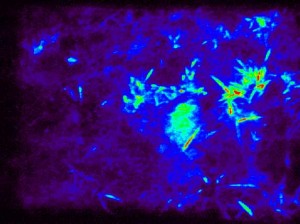
Synthetic biology and students are mixing with explosive results. Remember the international Genetically Engineered Machine competition we told you was coming? It happened, and while there were many amazing and interesting projects (we’ll have a story on that later) there’s one team that’s already gotten a lot of media hype. BBC News reported that students from University of Edinburgh have developed a new strand of bacteria that will glow green in the presence of land mines. That’s very close to the truth. The Edinburgh team has made some great strides in that direction but haven’t produced a working system yet. What they have made is a kooky (maybe even embarrassingly silly) video about their work. Check it out after the break.
Oak Ridge National Labs was developing a land mine detecting bacteria ten years ago that required UV illumination (the above image shows their results). The Edinburgh team hopes to improve upon the ORNL system by eliminating the need for complex lighting. Using the BioBrick parts provided by MIT, the Scottish team genetically modified a strand of bacteria (Rhodococcus rhodochrous) so that it will react to increased levels of nitrites in soils – this indicates the presence of TNT or RDX, important ingredients in most land mines. If successful, the Edinburgh bacteria could be mixed in a solution and sprayed on fields, allowing workers to locate and disarm the mines. With tens of thousands of deaths occurring each year due to abandoned mines and unexploded ordinance, this project has potential of saving the limbs and lives of victims, many of whom would be children. The project’s not done, but it certainly is an amazing endeavor for a group of college students.
[photo credit: Oak Ridge National Labs]



